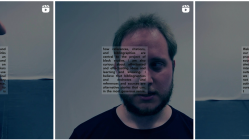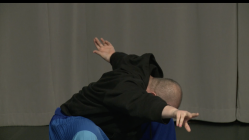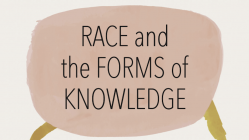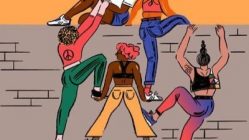“laboratory” (0:58). Illuminated video by Ben Spatz with Nazlihan Eda Ercin and Agnieszka Mendel. Edited by Ben Spatz. Videography byNazlihan Eda Ercin. Recorded at the Grotowski Institute, Wrocław, Poland. Judaica: Embodied Laboratory for Songwork, 2017.
Compare this 1-minute video with the 3-minute video ‘Dynamic Rhythms‘ produced in September 2016 as part of the new Songwork Catalogue. There are at least seven differences that illustrate how my work with audiovisuality has changed during the laboratory phase of the Judaica project:
1. In the 2016 video, I am improvising within a clearly defined exercise or structure of practice based on a song fragment. In the 2017 video, I am improvising freely, talking and weaving in and out of the song fragment. Overall the situation in the 2017 video feels more dynamic and alive — less like a controlled work demonstration — than the 2016 video.
2. As a corollary, the topic or aboutness of the video only appeared afterwards in the selection and framing of this particular moment. While the 2016 video was recorded in order to demonstrate “dynamic rhythms”, the 2017 video only afterwards appeared to be about the idea of the “laboratory”.
3. In the 2016 video, I am in charge of developing a structuring my own solo improvisation. In the 2017 video, I am receiving audible instructions and indications (“Yes!”) from Agnieszka Mendel, who is directing me as part of a dynamic working configuration.
4. The 2016 video was recorded by an external videographer who was hired on a freelance basis to work for me in the creation of this document. The 2017 video was recorded by Eda Erçin, who has taken the role of videographer in this particular working configuration as part of her larger participation in the six-month laboratory phase of the project.
5. In the 2016 video, I am demonstrating songwork in its narrowest sense (‘song-action’) as simply the life of the act of singing in the body, excluding books and any other objects. The 2017 video ends with me picking up a recent academic monograph — a possibility brought to the project through the visit of anthropologist Caroline Gatt.
6. In the 2016 video, textual information provides only the most basic information about the documented practice: title, practitioner, location. The 2017 video also includes a number of citations that open up the moment of practice to further inquiry in several directions.
7. The textual layer in the 2016 video appears only at the bottom in a visually separated bar, whereas in the 2017 video text appears on the screen in relation to the shifting visual image, at times almost dancing with the body.







[…] October 2017 Conference Media, Edited […]